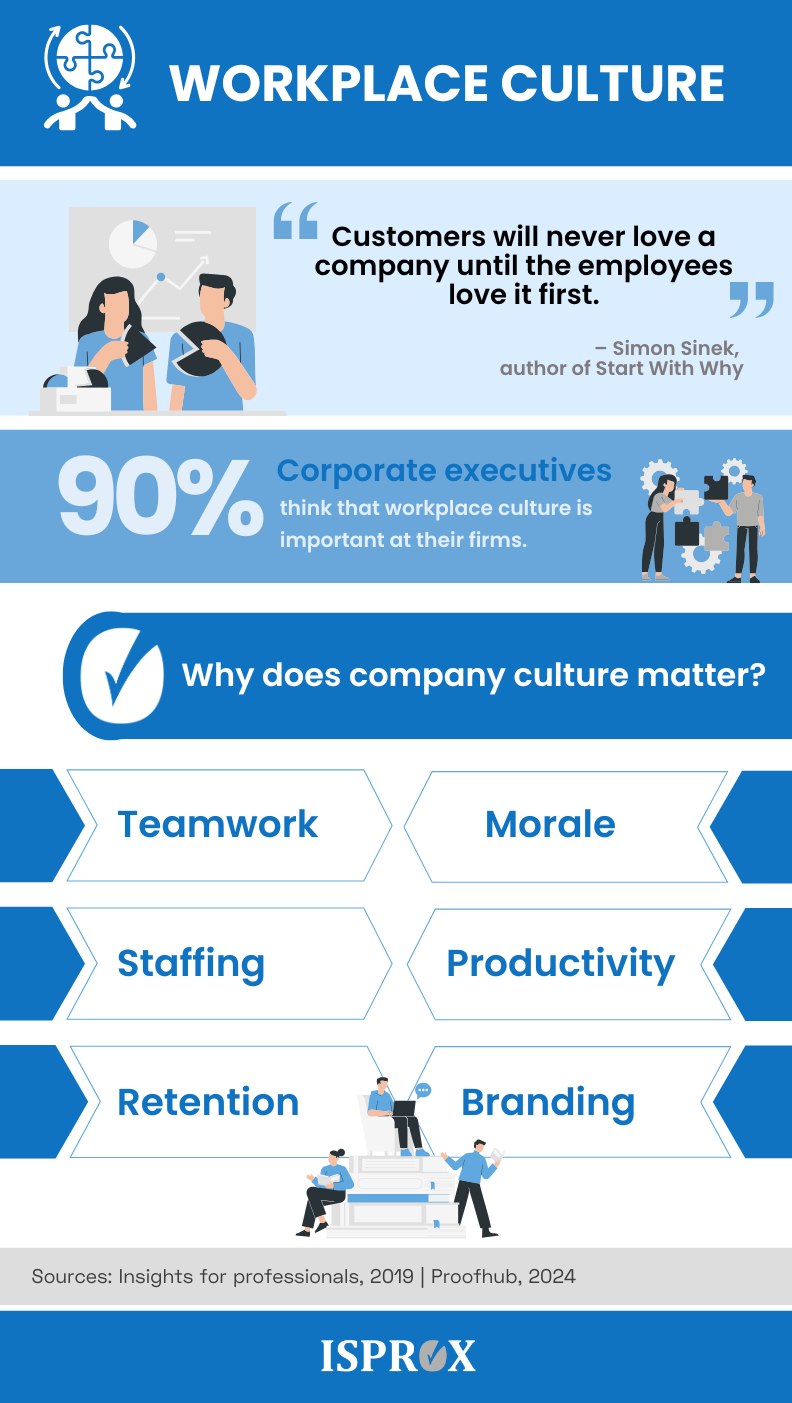Workplace culture has a direct impact on the employee morale, turnover, and experience in an organization. A positive and healthy workplace culture keeps employees engaged, motivated, and loyal. It is the backbone of any successful organization. It’s time to build and maintain a thriving workplace culture.
In this article, we’ll share practical tips that you can implement to improve your workplace culture and create a positive environment for everyone. But, first, let’s find out what exactly is a workplace culture.
Content
- What is workplace culture?
- 10 Tips to improve your workplace culture
- 1. Promote transparent communication
- 2. Build strong interpersonal relationships
- 3. Implement flexible work arrangements
- 4. Overcome organizational silos
- 5. Align actions with core values
- 6. Implement recognition and reward programs
- 7. Embrace employee autonomy
- 8. Communicate organizational mission and vision
- 9. Foster a culture of continuous feedback
- 10. Prioritize ongoing culture development
- Why should you improve workplace culture?
What is workplace culture?
It is hard to define workplace culture, but there are some definitions.
Forbes defines work culture as “the environment that surrounds us all the time.”
According to Indeed, it’s a “collection of attitudes, beliefs, and behaviors that make up the regular atmosphere in a work environment.”
Regardless of the definition, work culture is more about how it feels to be at work rather than a set of written rules.
Every organization has its personality and atmosphere, and that’s not something easy to create.
Importance of work culture
“Culture eats strategy for breakfast.” – Peter Drucker, the renowned management consultant and author.
Organizations are realizing that having the best strategy and people in the world doesn’t matter if your culture isn’t right. Culture is like the air you breathe. If it’s toxic, your workplace won’t survive.
But, what actually makes a work environment supportive and enjoyable for your employees?
Key elements of a positive workplace culture
Here are some key elements of a positive work culture that you need to cultivate.
- Good communication: A healthy company culture encourages open and transparent communication. Make sure your employees feel heard and respected. This will foster trust in business leadership and ensure commitment to the company’s overall mission.
- Mutual respect: Respect is another important aspect of organizational culture. Everyone should be treated with the same respect and equally regardless of responsibilities, roles, and authority.
- A collaborative environment: Teamwork and collaboration are also essential components of a strong corporate culture. A collaborative environment encourages team members to share information freely and provide opportunities for team-building.
- Clearly defined values: Finally, ensure that you have a clear mission and set of values. These cannot just be words thrown at marketing materials or company documents. You and your entire team must embody and uphold these values.

10 Tips to improve your workplace culture
A positive workplace culture entails happy employees, high productivity, and lower turnover rates. Here are ten practical tips to help you create a more vibrant and supportive work environment.
1. Promote transparent communication
Transparency creates a strong workplace culture. A transparent work environment keeps everyone in the loop, whether it’s about company goals, challenges, or decisions.
“Companies with high transparency levels are 30% more likely to retain their employees”, according to a Payscale research.
Transparency builds trust, increases employee engagement, and creates a safe environment where everyone feels valued and heard.
To create an open and transparent culture at work, you can start by using collaboration tools like ProofHub or GanttPRO that make it easy for everyone to stay connected, especially in remote or multi-office settings.
Regular updates, open forums, and accessible information help bridge gaps and ensure everyone is on the same page.
2. Build strong interpersonal relationships
Strong interpersonal relationships at work keep employees engaged. When employees feel connected to their colleagues productivity naturally increases.
According to a Gallup study, “Having a best friend at work can lead to higher job satisfaction and performance.”
Encourage team bonding through regular team-building activities or casual meet-ups like coffee breaks or group lunches. These interactions allow your employees to connect on a personal level and improve performance.
Plus, you can create spaces at work that promote spontaneous conversations, such as a communal kitchen or lounge area.
3. Implement flexible work arrangements
A FlexJobs survey found that 80% of employees are more loyal to companies that offer flexibility. Flexible options, like offering remote work, flex time, or four-day work weeks, give employees the freedom to manage their work-life balance better.
For example, allowing an employee to work from home when they have family commitments, unexpected personal challenges, or long commutes. This will help them reduce stress and boost morale, enhancing job satisfaction and reducing turnover rates.
So, you need to understand your team’s needs and create policies that accommodate them. Adjust office hours or introduce remote work days to show you value your employees’ well-being and support them.
4. Overcome organizational silos
Organizational silos occur when teams or departments work in isolation, leading to a lack of collaboration and communication across the company. This separation creates misunderstandings, slows down progress, and weakens everyone’s morale.
To overcome silos, you need to foster open communication in your workplace. Hold regular cross-departmental meetings or organize team-building activities where employees can share ideas and collaborate on projects. This helps you build trust and breaks down barriers between teams.According to a Stanford study, companies with strong workplace collaboration are five times more likely to be high-performing. You can create a cohesive work environment by uniting all employees as a single team rather than separate groups. This leads to better teamwork, increased innovation, and a positive workplace culture.
5. Align actions with core values
Core values are more than just words on a website, they act as your company’s guiding principles, shaping decisions and behaviors. When your actions reflect these values, employees feel a stronger sense of purpose and connection to the organization.
So, clearly define your core values and ensure they resonate with your mission. Regularly communicate these values and recognize employees who embody them. For example, if one of your core values is integrity, celebrate when team members demonstrate honesty, even in challenging situations.
As leadership expert Lolly Daskal said, “Your values define what is significant and meaningful to you.” By living these values daily, you reinforce a culture that is authentic, inspiring, and resilient.
6. Implement recognition and reward programs
When employees feel appreciated, they are more likely to stay motivated and committed to their work. According to a study, nearly half of employees have left a job because they felt underappreciated, while 65% said they’d work harder if their efforts were recognized. So, regularly recognize and reward your employees for their hard work.
Identify behaviors and achievements that align with your company’s goals. Then, acknowledge these contributions, whether through verbal praise, awards, or bonuses.
Recognition shouldn’t just come from the top. Peer-to-peer recognition is incredibly effective and helps integrate appreciation into daily interactions. Involve everyone in the process and create a supportive environment where team members are valued by their colleagues and leaders alike.
7. Embrace employee autonomy
Micromanagement stifles creativity and trust, which no one enjoys. Embracing employee autonomy gives your team the freedom to make decisions and manage their work. This boosts job satisfaction and enhances productivity.
According to a study, 79% of autonomous employees are more engaged compared to those who lack autonomy.
To foster employee autonomy in your workplace, let your employees have a say in their projects and working methods. Move away from rigid 40-hour workweeks and let them work in a way that suits them best.
Create independent work groups and allow employees to make decisions related to their roles. And, most importantly, keep micromanagers in check. Trusting your team empowers them and fosters a dynamic and innovative workplace.
8. Communicate organizational mission and vision
Mission and vision form the core of a workplace culture. When employees understand and connect with these core elements, they feel more engaged and motivated.
According to research, when people believe their work is important, they’re four times more likely to be interested, motivated, and satisfied. Yet, Gallup reports that many employees still feel disconnected from their company’s mission.
To improve this, clearly communicate your mission and vision with the team. Regularly discuss how each team member’s role contributes to the larger goals. Share stories of how individual efforts align with the mission and celebrate milestones. This reinforces the organization’s purpose and helps employees feel valued and connected.
Today, having a feeling of purpose at work seems more crucial than ever. According to research, when people believe their work is important, they are four times more likely to be interested, motivated, learn faster, and satisfied.
9. Foster a culture of continuous feedback
Continuous feedback involves consistently providing and receiving constructive feedback throughout the year. Instead of waiting for an annual review, offer feedback during one-on-one meetings and encourage your team to share their thoughts as well.
This helps both you and your employees to address issues and celebrate successes as they occur. Regular feedback keeps everyone informed and motivated.
A recent Gallup study found that 84% of employees who received fast feedback reported being engaged in their work, compared to only 15% who said they were not engaged.
Genuine feedback allows you to recognize positive behaviors and guide those who may be struggling, preventing surprises during annual reviews.
So, schedule regular check-ins, use employee engagement surveys to pinpoint areas for improvement, and foster an open environment where feedback flows freely.
10. Prioritize ongoing culture development
Building a great workplace culture is a continuous process. Your culture needs regular care and attention to thrive. You need to consistently align your company’s values and mission with daily practices. This will make your employees feel valued and engaged, ultimately boosting productivity and satisfaction.
By investing in your company culture, you can improve organizational performance, cultivate satisfied employees, and drive higher revenue growth.
So, make time to nurture and embody your company culture daily. Your dedication will inspire your team to do the same, creating a vibrant and supportive workplace where everyone thrives.
Why should you improve workplace culture?
Improving your workplace culture makes your employees happy and lets you build a thriving business. Here are a few benefits of improving your work environment:
- Retain top talent: A great culture makes your company a place where skilled employees want to stay. People stick around when they feel valued and supported.
- Keep employees engaged: When your workplace culture is strong, employees feel connected to their work and are more motivated to contribute.
- Improve productivity: A positive culture encourages teamwork and efficiency, leading to higher productivity across the board.
- Drive innovation: In a supportive environment, employees openly share ideas and take creative risks, driving innovation.
- Produce better business outcomes: A strong culture leads to improved performance, which means better results for your organization.
A positive workplace culture is the foundation for long-term success of your organization. It lets you make happier employees, better collaboration, and sustained growth. Every small step you take to improve your workplace culture adds up, creating an environment where everyone thrives.
Are you looking for talent to expand your team?
At ISPROX we help you find the right profile, saving you time and increasing your hiring success rate.










